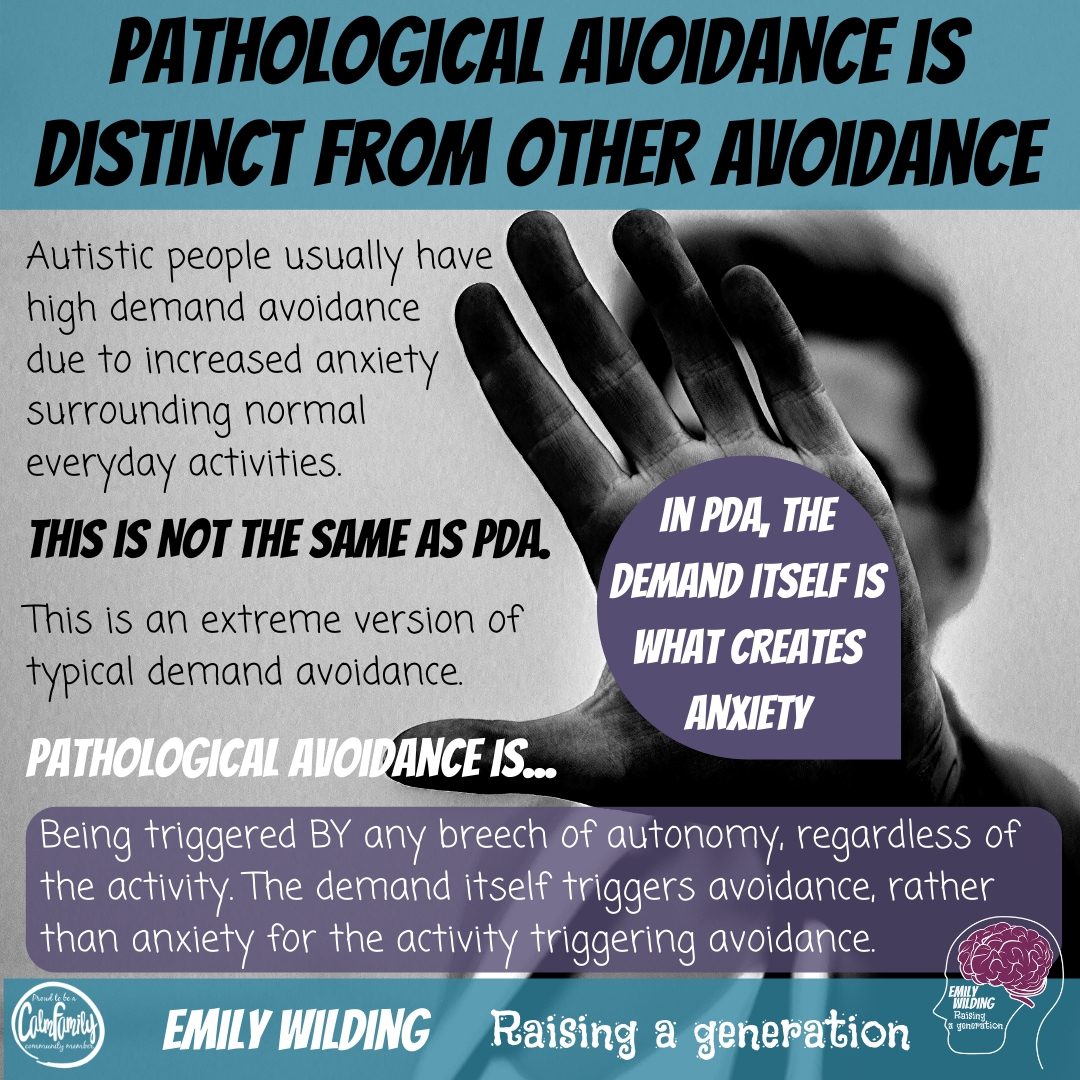So many professionals, "experts" other autistics and even people in the PDA community do not understand this distinction and it is important. There is a term "autistic demand avoidance" and many people believe PDA is just that.
It is Not.
So you can see how people think it is the same when PDA is described often as "someone who avoids the demands of everyday life".

Equally, when any autistic person is in a constantly high state of anxiety, they can become avoidant of doing anything at all. This extreme avoidance is consistent with autistic shut down, or burn out depending on the circumstances. This is not pathological avoidance. Autistic people are triggered by the thought of doing something that brings them anxiety (socialising, going somewhere new etc), and they avoid it at all costs. This is autistic demand avoidance, and it is very much like normal, typical demand avoidance found in all humans, but more frequent, more extreme and potentially surrounding more things. This is still not pathological.
Pathological, in this case means, significantly extreme to be considered "hard-wired" and significantly different from the norm so as to be problematic. Avoiding things you are afraid of is normal, even if the anxiety is to an extreme level. Here is how pathological avoidance is different.
PDAers are triggered by the demand itself. The nature of this neurotype is significantly different from other autism. PDAers are driven by a pervasive and intense need for autonomy. Any breech of autonomy is perceived as a serious threat, causing anxiety, avoidance and threat response. Demands, requests, reminders, expectations and anything that removes self-direction and personal freedom triggers avoidance.
|
Normal demand avoidance =
|
Avoidance of things we are afraid of (anxiety), don't want to do (no motivation), or feel we cannot manage (executive function).
|
|
Autistic demand avoidance =
|
Normal avoidance coupled with unusually high and varied anxiety and executive function difficulty. The higher level of anxiety can make avoidance extreme.
|
|
Pathological demand avoidance =
|
Avoidance of real and perceived demand or imposed control, regardless of the content of the demand or activity.
|
This blog post was shared in a PDA group on FB. I’m so glad I found it, it completely sums up my son and why he is so challenging for adults to comprehend. He’s social, smart, charismatic and absolutely impossible at times. His hierarchal blindness combined with hatred of rules and love of freedom/autonomy puts him at risk, and therapists are continually trying strategies to teach him alternative behaviours, while I watch knowing full well they won’t make any difference. It who he is to his core.
Thanks for sharing your journey with the world Emily.
Best article I’ve read describing the difference, what PDA is and feels like. Thank you!
Such a relief to finally find a plausible explanation as to why my adult son behaves as he does. Ive had to work it out for myself doing lots of research over the years. As I child I knew he was different but was just told not to worry, he’ll grow out of it! The implication being I was an over anxious mother. No one took me seriously. Since then I suspect he has Asperger’s although he refuses to ask for a diagnoses as he has explained “a label automatically excludes him from seeking work in some jobs”. A correct fact (now I see this as an excuse), an avoidance issue because confronting it will just cause him too much anxiety. Supporting him to become an independent adult has consumed our lives and cost us both from a health and financial perspective. This explanation of PDA fits him like a glove. The final piece of the puzzle was understanding the difference between PDA and the same symptoms caused by autism. Understanding what is going on helps cope with the circumstances we find ourselves in as a family. Thank you. I would def be interested in any course you set up.
Hi Emily,
This so describes my son (age 5) who has autism. I’d didn’t realize this was something that was diagnosed. Do you have tips on how to deal with this?
Hi. I will be writing more about this in due course and am considering writing an online course to educate and support parents and carers. Is this something you might be interested in? There is some useful information on the PDA Society website as well.
Hi Emily I would definitely be interested. Adopting a low demand lifestyle has been a game-changer, but still still have a long ways to go in healing the traumas that occurred before we were aware of any o this, plus the processing of the grieving that comes along with this PDA realization. Thank you!
My 11yr old shows lots of.the PDA identifiers am trying to.find out more about itnas they dont diagnose it.in east sussex
Diagnosis is still really tricky even in the UK where it is arguably the most well recognised.